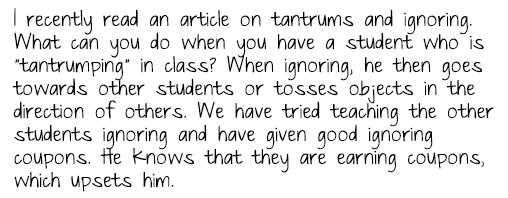Sometimes we get questions from school teachers and parents about managing problem behaviors. Our BCBA Sam Blanco recently received a question from a school teacher in Alabama about her tantruming student in the classroom. We thought this was a perfect opportunity to share Sam’s response to her question as it may often apply to other parents and teachers. Read on below for the question and Sam’s response!

Addressing difficult behaviors in the classroom environment presents some unique challenges. It’s also challenging to provide accurate advice without directly observing the behavior. Instead, here are a few questions to consider and potential resources.
- What does the tantrum look like when it begins? Is he screaming? Crying? Throwing items? Banging his desk? Try to define the behavior so it is observable and measurable. If it’s observable, then everyone who interacts with the child will agree with exactly what behavior requires intervention. If it’s measurable, you will be able to easily note progress. An observable and measurable definition of a tantrum could be “Screams and cries for 10-12 minutes” or it could be “Stomps his feet on the ground 20-30 times.”
- What is typically happening directly before a tantrum takes place? What typically happens directly before it escalates? Can you change something about what happens directly beforehand that might impact his behavior?
- What is different about the environment on days/class periods in which he does not tantrum? Is it something you can replicate on other days/class periods?
- You should conduct a functional assessment to clearly determine the reason for the behavior. It may be for attention, but you may discover there is a different cause. It is best to perform a formal functional analysis, but if that is not possible, you may consider using the Functional Analysis Screening Tool (FAST). To get the best results from this, you should have more than one person fill it out, and, if possible, one person who observes the behavior but is unfamiliar with the child. Compare results to see if you are in agreement, then make a behavior intervention plan based on the function of the behavior. For more information about the FAST and its reliability compared to a formal functional assessment, you should refer to the study by Iwata, Deleon, & Roscoe (2013).
- Frequently, tantrums in classrooms start when a demand has been placed. This may be because they are attempting to escape the demand, but it may also be because the demand is a signal that attention may become available (Repp & Karsh, 1994). If you determine that it is, in fact, for attention, are there things you can do to provide high quality attention prior to the tantrum? Perhaps you find that he usually works for about three minutes before he starts to tantrum. You can then provide high quality attention for successfully working for three minutes and label his appropriate behaviors. Over time, you systematically increase the number of minutes he works before accessing that high quality attention. The goal is to provide him with plenty of opportunities for success before he begins to tantrum.
- A strong classroom token economy may be more successful than “good ignoring coupons.” For example, when I was a classroom teacher, I used paperclips for the tokens. Each student had a bag on the chalkboard with his/her name on it and they earned paperclips throughout the day for a variety of positive behaviors. At the end of the day, we counted paperclips and students could choose to save them or spend them on one of the items on a student-created menu of choices. The paperclips worked because they weren’t designed for a specific behavior. In the instance you described, the boy is put in a position where he has no chance to earn a coupon. However, if the language is changed so that when other students earn for ignoring, you say, “You’re earning a coupon/paperclip/token for sitting quietly at your desk,” the boy now has a decision to continue his inappropriate choices, or work to earn the same coupon the other kids are earning. He may still choose to tantrum, but at least now he has options!
- The Lovaas Institute blog has a great post about addressing challenging behaviors in the classroom. You can view that here.
Hopefully this information has helped! And good luck as you plan your intervention!
WRITTEN BY SAM BLANCO, MSED, BCBA
Sam is an ABA provider for students ages 3-12 in NYC. Working in education for ten years with students with Autism Spectrum Disorders and other developmental delays, Sam has developed strategies for achieving a multitude of academic, behavior, and social goals.
